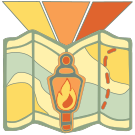Guide: Witnessing

The Concept
Witnessing is a practice where one observes their own mind, thoughts, and emotions from a detached perspective. It's like being a neutral observer or "witness" to your own experiences, without judgment or attachment. This can be practiced in everyday life by consciously paying attention to your thoughts and feelings as they arise, without getting swept up in them. By becoming a "witness" to your own mental processes, you can gain a greater understanding of yourself and your reactions to different situations. The ultimate goal is to develop a greater sense of self-awareness and self-understanding, leading to increased control over your thoughts and emotions.
For example, while doing common tasks, practice relaxing your hold on the concept that you have some sort of consciousness that directs your actions. Try to be the most mindful you can, and simply let your hold on The Self go, riding the stream of events that takes you through the task. You can do these exercises while doing any task at all, not just chores, but it may be easier to start with simple household tasks that you do every day.
Why
As you unlearn The Self, you should be able to apply that awareness in a progression something like this.
- Small, rote tasks - combing your hair
- More complex tasks - emptying the dishwasher
- Medium complex tasks - writing an email
- Very complex tasks - writing a creative paragraph
- Long Durations - shopping
- Everyday Enlightenment
How
Each exercise will feel a little different, and there are some ideas below, but the general pattern is
- Start your task
- Become as mindful as you know how, let all thoughts evaporate, let go of any need to understand or control the moment
- Appreciate the task as a whole, sensing that it will get accomplished without you having to push it
- Begin to slowly appreciate the major steps or movements necessary to get the task done
- Once you have learned what you need from this "top down" approach, reverse the flow of observation...
- Note that the tiniest muscle movements you need for anything will never be under your conscious control - there are thousands of micromovements taking place each second
- Move up from that into an awareness of small movements that happen without any conscious thought
- Continue to move further up into the larger motions and how they also are simply taking place
- Finally note how decision making (such as when to change the comb to another hand) also do not require conscious thought
The exercises below may seem very prescriptive, describing exactly what to do at each step but do not approach them that way. These are just examples showing what someone might experience, and your experience will not follow the steps given. Instead, you will have to observe your own experience and then go back and reread the exercises to understand the objective. And then try again.
